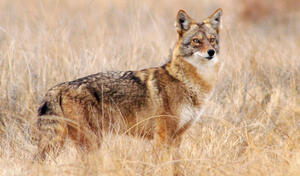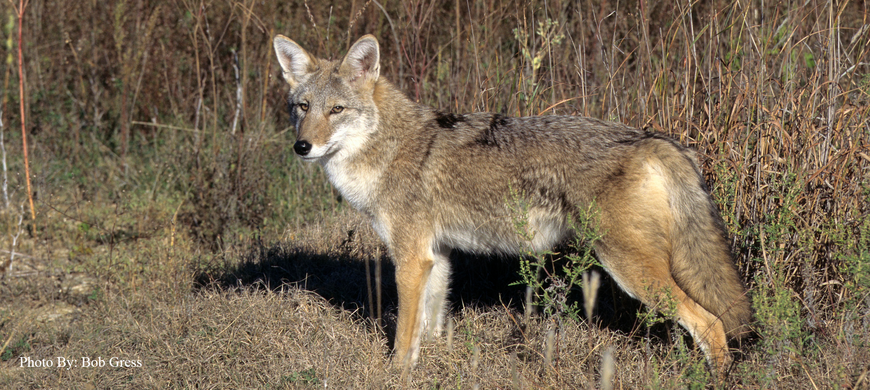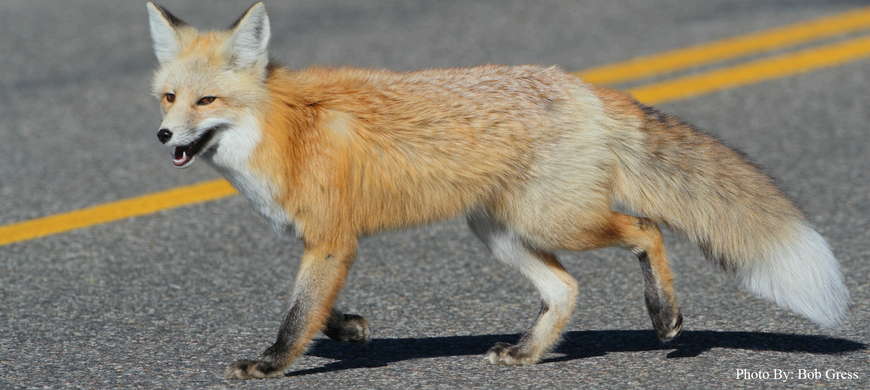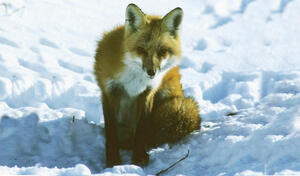Coyote

Coyotes (Canis latrans) are not legally classified as furbearers in Kansas, but in many ways, they are monitored and managed as if they were. Coyotes are actually considered nongame, as a result of historic attitudes and the potential for conflict with the livestock industry. They are not afforded the protection of a harvest season like our furbearers, but their cunning and adaptability are legendary, and it is difficult to conceive a more resilient animal. After surviving decades of cyanide guns, strychnine-laced carcasses, widespread trapping and shooting, bounties, and the all-out ire of mankind, the coyote has responded by expanding its range eastward into parts of the United States where it had not previously existed. In recent times, coyotes have become increasingly adapted to urban life, and have been implicated for attacking pets and even people in a few states where trapping bans have outlawed the most effective harvest technique.
The coyote ranges throughout Kansas from woodlots in the east, through the grasslands of the Flinthills, to the intensively-managed agricultural landscape in the west. It is easily distinguishable from other wild members of the canid family in Kansas by its larger size (usually 25-35 pounds) and coloration. In captivity, the coyote’s lifespan is not unlike that of a domestic dog, but it rarely lives past six or eight years in the wild. Mortality is probably mainly due to hunting, trapping, and roadkill, but coyotes are also susceptible to various diseases and parasites including sarcoptic mange, canine distemper, and heartworm.
Most coyotes occupy and defend a distinct territory, often with a mate, but some are wide-ranging transients that persist on the fringe of the home ranges of more territorial coyotes. Home range sizes vary by food availability, pack size, and coyote density, but probably average 8-15 square miles in Kansas. Coyotes communicate by scent marking and various vocalizations. Their widely-recognized howl has long been a symbol of the lonesome prairie and adds greatly to the mystique that surrounds the species in Western and Southwestern folklore.
Coyotes usually mate in February or March, and pups are usually born in a den or hollow in April or May. Four to seven pups are common, but as many as 17 may be born when food is especially abundant. The coyote has a very diverse and seasonal diet. Though diet consists primarily of mice, voles, and rabbits, coyotes feed heavily on plums, sunflower seeds, pears, watermelons, and other fruits, berries, nuts, seeds, and invertebrates when they are available in the summer and fall. In the winter, carrion including livestock and deer often becomes an important dietary component. Coyotes also sometimes prey on domestic poultry and livestock in Kansas, though often they are blamed for the depredations of free-ranging domestic dogs.
Coyotes have usually ranked second or third annually in total value of pelts harvested in Kansas. In recent times, about 15,000 have been harvested each year by licensed furharvesters, with perhaps another 60,000 to 70,000 taken by hunting license holders. Even though the cunning nature of the coyote makes it one of the most difficult species to trap, foothold trapping is usually the most effective harvest technique. Coyotes are also the most common quarry of predator callers.
Dates: 01/01/2025 - 01/01/2026
Season Dates (statewide): All year
Season Limit: No limit
There is no closed season for trapping or hunting coyotes. Motor vehicles and radios in vehicles may be used to hunt coyotes only. Furharvester license is required to trap and sell; hunting license is required to hunt and sell.












